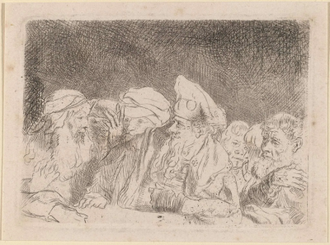Gospel in Art: There are many observances which have been handed down

The Pharisees Debating, by Rembrandt van Rijn © National Gallery of Art, Washington
Source: Christian Art
Gospel of 1 September 2024
Mark 7:1-8, 14-15, 21-23
The Pharisees and some of the scribes who had come from Jerusalem gathered round Jesus, and they noticed that some of his disciples were eating with unclean hands, that is, without washing them.
For the Pharisees, and the Jews in general, follow the tradition of the elders and never eat without washing their arms as far as the elbow; and on returning from the market place they never eat without first sprinkling themselves.
There are also many other observances which have been handed down to them concerning the washing of cups and pots and bronze dishes. So these Pharisees and scribes asked him, 'Why do your disciples not respect the tradition of the elders but eat their food with unclean hands?' He answered, 'It was of you hypocrites that Isaiah so rightly prophesied in this passage of scripture:
This people honours me only with lip-service, while their hearts are far from me.
The worship they offer me is worthless, the doctrines they teach are only human regulations.
You put aside the commandment of God to cling to human traditions.'
He called the people to him again and said, 'Listen to me, all of you, and understand. Nothing that goes into a man from outside can make him unclean; it is the things that come out of a man that make him unclean. For it is from within, from men's hearts, that evil intentions emerge: fornication, theft, murder, adultery, avarice, malice, deceit, indecency, envy, slander, pride, folly. All these evil things come from within and make a man unclean.'
Reflection on the Etching
Many of you may know the beautiful hymn 'Abide with Me, Fast Falls the Eventide'. It was written by Henry Lyte, an Anglican minister who served as a curate in Taghmon, County Wexford, from 1815 to 1818. A plaque in Taghmon Church commemorates his frequent preaching at Killurin Church, about nine miles away. It is believed that Lyte composed the hymn in 1820 while visiting his dying friend, William Augustus Le Hunte. As William repeated the phrase "abide with me," Lyte was inspired to write the hymn, later giving a copy to William's family. Shortly before his own death, Lyte composed the music, and the hymn was first sung at his funeral in 1847. The second verse ends with the lines, 'Change and decay in all around I see; O Thou who changest not, abide with me'. This acknowledges that while everything in life changes, God remains constant.
If God alone is unchanging, then everything else, including long-standing religious traditions, is subject to change. In today's Gospel reading, Jesus clashes with the religious leaders who ask, 'Why do your disciples not follow the tradition of the elders?' They were referring to various ritual washings they deemed unchangeable. Earlier in Mark's gospel, Jesus told his critics, 'No one puts new wine into old wineskins'. He implied that some old religious traditions couldn't contain the new wine of God's enduring love, present in his own person and ministry. The presence of God made flesh in Jesus required openness to change, necessitating the constant renewal of religious practices and structures. Jesus did not reject his Jewish tradition but critiqued aspects of it from within. He quotes from Isaiah to show that God's primary concern was not external rituals but the state of people's hearts.
Our etching by Rembrandt from circa 1649 depicts a group of Pharisees engaged in a heated debate. Rembrandt captures the intensity and drama of the scene with meticulous detail and expressive characters. The Pharisees are shown in elaborate robes, gesticulating and interacting with one another, as they would have done in our Gospel reading today. Their faces and postures convey a range of emotions from sternness to contemplation. By 1649, Rembrandt was an established artist, though he faced financial difficulties later in his life. This print represents his mature style, characterised by dramatic use of light (foreground) and shadow (background) and deep psychological insight into his subjects.
LINKS
Gospel in Art: https://christian.art/
Today's Reflection: https://christian.art/daily-gospel-reading/mark-7-1-8-14-15-21-23-2024/



















